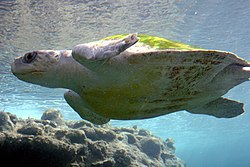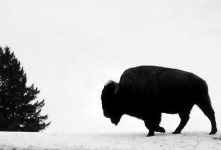 Fish Farms Drive Wild Salmon Populations Toward Extinction
Fish Farms Drive Wild Salmon Populations Toward Extinction
Science Daily - www.sciencedaily.com
13 Dec 2007
Parasitic sea lice infestations caused by salmon farms are driving nearby populations of wild salmon toward extinction. The results show that the affected pink salmon populations have been rapidly declining for four years. The scientists expect a 99% collapse in another four years, or two salmon generations, if the infestations continue.
"The impact is so severe that the viability of the wild salmon populations is threatened," says lead author of a new article in Science (December 14) Martin Krkosek, a fisheries ecologist from the University of Alberta. Krkosek and his co-authors calculate that sea lice have killed more than 80% of the annual pink salmon returns to British Columbia's Broughton Archipelago. "If nothing changes, we are going to lose these fish."
Global Warming Is Destroying Coral Reefs, Major Study Warns
Science Daily - www.sciencedaily.com
14 Dec 2007
The largest living structures on Earth and the millions of livelihoods which depend upon them are at risk, the most definitive review yet of the impact of rising carbon emissions on coral reefs has concluded.
If world leaders do not immediately engage in a race against time to save the Earth's coral reefs, these vital ecosystems will not survive the global warming and acidification predicted for later this century. That is the conclusion of a group of marine scientists from around the world in a major new study published in the journal Science on Dec. 13.
 Hundreds of dead turtles litter Orissa beach
Hundreds of dead turtles litter Orissa beachEarthtimes.org – www.earthtimes.org
13 Dec 2007
Area: Gahirmatha beach, Orissa, India
Image courtesy of Wikipedia
Hundreds of endangered Olive Ridley turtles were found dead over the past one and half month in Orissa's Gahiramatha beach, a non-governmental organisation here said Thursday.
'We have been conducting survey of turtles on the 35 km shoreline from Hukitola to Nasi Island of Gahirmatha, nearly 174 km from the state capital Bhubaneswar, since Nov 1,' said Bijay Kabi, director of the NGO Action for Protection of Wild Animal (APOWA).
'We found carcasses of at least 400 turtles on the beach,' he said, adding, 'Many of them might have been killed by fishing trawlers that are operating illegally in the vicinity'.
Dorset marine wildlife threatened by millions of plastic pellets
Wildlife Extra.com - www.wildlifeextra.com
2007 Dec
Area: Kimmeridge, Dorset, England
December 2007. Volunteers for Dorset Wildlife Trust’s beach clean at Kimmeridge last Sunday were horrified to find a white beach. On closer inspection this turned out not to be snow or Caribbean sand, but millions of tiny plastic pellets called nurdles. Too small to pick up and too numerous to count, these pellets will remain on the beach with potentially lethal consequences. They were almost certainly lost from the Napoli, grounded in Lyme Bay last January.
Nurdles are the basic material from which plastic products are made. Transported in massive containers to factories, they are turned into CDs, drainpipes, food containers and virtually anything plastic. They often end up in the sea, washed down factory drains or, as in this case, lost from container ships. As they float on the surface of all the world’s oceans they attract toxins from the water and are swept onto beaches with each tide.
Habitat at risk for Jackass Flats bighorn herd
The Hub - www.ouraynews.com
14 Dec 2007
K Griffiths
Scientists, wildlife agencies and advocates along with many Ouray County residents and property owners remain alert to the conditions afforded for Ovis canadensis, commonly known as Rocky Mountain bighorn sheep. This is particularly true concerning a 41-acre parcel called Jackass Flats used as a wintering area by the sheep north of Ouray near Lake Lenore and the Bachelor-Syracuse mine.
. . . Studies show that Rocky Mountain bighorn sheep have a low tolerance level for handling stress, expressly stress caused by close proximity to humans and dogs. Human development and recreational use of land around the remaining fragments of bighorn sheep wintering ground such as Jackass Flats pose the risk of alarming the sheep thereby raising their stress level leading to weakened physical conditions, pneumonia and other complications like aborted lambs.
Indian alligators found dead in Chambal River
The Cheers magazine – www.thecheers.org
13 Dec 2007
Area: Chambal River, Uttar Pradesh, India
In a shocking incident, several Indian alligators (Gharials) have been found dead in the Chambal River in Etawah's Chakar Nagar sub-division of Uttar Pradesh. The main habitat for crocodiles and alligators in India are the Rivers Chambal, Girwa, Rapti and Narayani in the orbit of central and northern India.
. . . "The forest department has conducted a post-mortem on two to three Gharials. The Gharials were recently brought from Lucknow's Kukrail Gharial Rehabilitation Centre, and they might have become victims of some contagious disease or the target of some hunters," claimed Rajeev Chauhan, the Secretary of the Society for the Conservation of Nature.
OTHER RELATED WILDLIFE DISEASE NEWS
Photo of Red Tide courtesy of Wikipedia
 Can Interacting Pathogens Explain Disease Patterns?
Can Interacting Pathogens Explain Disease Patterns?- Oil spill hurts nature and business [Scientific American Video]
- Wild Monkeys Exported To Sumter County
- Coyote tests positive for rabies
- Fall Survey: Delta Smelt And Other Fish Populations On Downward Spiral
- Brevard issues red tide health alert
- Oil, gas rules to look at health, wildlife effects: Drillers doubt deadlines can be met for new regulations
- Experts publish findings on rare infection from buffalo
- County supervisors table ordinance to prohibit the feeding of wildlife
- Foot and mouth outbreak scientists blame Defra
- Foot-and-mouth outbreaks connected
- Bird flu revives in Vietnam
WILDLIFE DISEASE RELATED PUBLCIATIONS
Avian Diseases - December 2007
Volume 51, Number 4
Table of Contents
Science. 2007 Dec 14 [subscription required]
- FREE podcast: Wild Salmon Populations in Peril; Storing Light in an Optical Fiber; International Year of the Reef 2008 [Listen to MP3 – 44 minutes]
- Declining Wild Salmon Populations in Relation to Parasites from Farm Salmon [abstract only]
- Habitat Split and the Global Decline of Amphibians [abstract only]





















